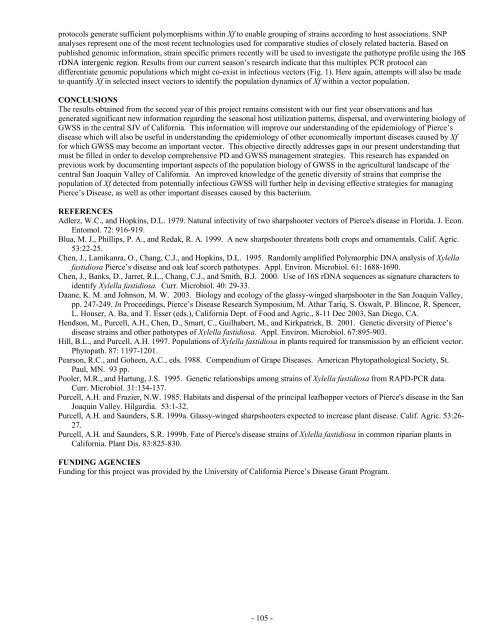Impact Of Host Plant Xylem Fluid On Xylella Fastidiosa Multiplication ...
Impact Of Host Plant Xylem Fluid On Xylella Fastidiosa Multiplication ...
Impact Of Host Plant Xylem Fluid On Xylella Fastidiosa Multiplication ...
Create successful ePaper yourself
Turn your PDF publications into a flip-book with our unique Google optimized e-Paper software.
protocols generate sufficient polymorphisms within Xf to enable grouping of strains according to host associations. SNP<br />
analyses represent one of the most recent technologies used for comparative studies of closely related bacteria. Based on<br />
published genomic information, strain specific primers recently will be used to investigate the pathotype profile using the 16S<br />
rDNA intergenic region. Results from our current season’s research indicate that this multiplex PCR protocol can<br />
differentiate genomic populations which might co-exist in infectious vectors (Fig. 1). Here again, attempts will also be made<br />
to quantify Xf in selected insect vectors to identify the population dynamics of Xf within a vector population.<br />
CONCLUSIONS<br />
The results obtained from the second year of this project remains consistent with our first year observations and has<br />
generated significant new information regarding the seasonal host utilization patterns, dispersal, and overwintering biology of<br />
GWSS in the central SJV of California. This information will improve our understanding of the epidemiology of Pierce’s<br />
disease which will also be useful in understanding the epidemiology of other economically important diseases caused by Xf<br />
for which GWSS may become an important vector. This objective directly addresses gaps in our present understanding that<br />
must be filled in order to develop comprehensive PD and GWSS management strategies. This research has expanded on<br />
previous work by documenting important aspects of the population biology of GWSS in the agricultural landscape of the<br />
central San Joaquin Valley of California. An improved knowledge of the genetic diversity of strains that comprise the<br />
population of Xf detected from potentially infectious GWSS will further help in devising effective strategies for managing<br />
Pierce’s Disease, as well as other important diseases caused by this bacterium.<br />
REFERENCES<br />
Adlerz, W.C., and Hopkins, D.L. 1979. Natural infectivity of two sharpshooter vectors of Pierce's disease in Florida. J. Econ.<br />
Entomol. 72: 916-919.<br />
Blua, M. J., Phillips, P. A., and Redak, R. A. 1999. A new sharpshooter threatens both crops and ornamentals. Calif. Agric.<br />
53:22-25.<br />
Chen, J., Lamikanra, O., Chang, C.J., and Hopkins, D.L. 1995. Randomly amplified Polymorphic DNA analysis of <strong>Xylella</strong><br />
fastidiosa Pierce’s disease and oak leaf scorch pathotypes. Appl. Environ. Microbiol. 61: 1688-1690.<br />
Chen, J., Banks, D., Jarret, R.L., Chang, C.J., and Smith, B.J. 2000. Use of 16S rDNA sequences as signature characters to<br />
identify <strong>Xylella</strong> fastidiosa. Curr. Microbiol. 40: 29-33.<br />
Daane, K. M. and Johnson, M. W. 2003. Biology and ecology of the glassy-winged sharpshooter in the San Joaquin Valley,<br />
pp. 247-249. In Proceedings, Pierce’s Disease Research Symposium, M. Athar Tariq, S. Oswalt, P. Blincoe, R. Spencer,<br />
L. Houser, A. Ba, and T. Esser (eds.), California Dept. of Food and Agric., 8-11 Dec 2003, San Diego, CA.<br />
Hendson, M., Purcell, A.H., Chen, D., Smart, C., Guilhabert, M., and Kirkpatrick, B. 2001. Genetic diversity of Pierce’s<br />
disease strains and other pathotypes of <strong>Xylella</strong> fastidiosa. Appl. Environ. Microbiol. 67:895-903.<br />
Hill, B.L., and Purcell, A.H. 1997. Populations of <strong>Xylella</strong> fastidiosa in plants required for transmission by an efficient vector.<br />
Phytopath. 87: 1197-1201.<br />
Pearson, R.C., and Goheen, A.C., eds. 1988. Compendium of Grape Diseases. American Phytopathological Society, St.<br />
Paul, MN. 93 pp.<br />
Pooler, M.R., and Hartung, J.S. 1995. Genetic relationships among strains of <strong>Xylella</strong> fastidiosa from RAPD-PCR data.<br />
Curr. Microbiol. 31:134-137.<br />
Purcell, A.H. and Frazier, N.W. 1985. Habitats and dispersal of the principal leafhopper vectors of Pierce's disease in the San<br />
Joaquin Valley. Hilgardia. 53:1-32.<br />
Purcell, A.H. and Saunders, S.R. 1999a. Glassy-winged sharpshooters expected to increase plant disease. Calif. Agric. 53:26-<br />
27.<br />
Purcell, A.H. and Saunders, S.R. 1999b. Fate of Pierce's disease strains of <strong>Xylella</strong> fastidiosa in common riparian plants in<br />
California. <strong>Plant</strong> Dis. 83:825-830.<br />
FUNDING AGENCIES<br />
Funding for this project was provided by the University of California Pierce’s Disease Grant Program.<br />
- 105 -











